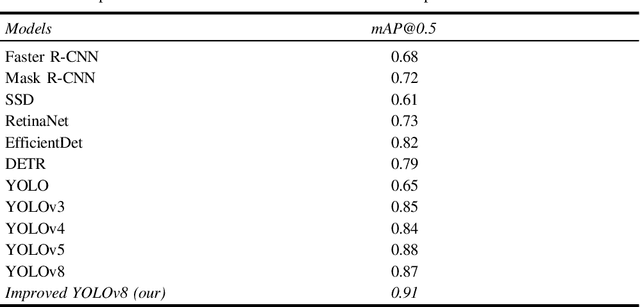Rabin Dulal
Brain Tumor Identification using Improved YOLOv8
Feb 06, 2025



Abstract:Identifying the extent of brain tumors is a significant challenge in brain cancer treatment. The main difficulty is in the approximate detection of tumor size. Magnetic resonance imaging (MRI) has become a critical diagnostic tool. However, manually detecting the boundaries of brain tumors from MRI scans is a labor-intensive task that requires extensive expertise. Deep learning and computer-aided detection techniques have led to notable advances in machine learning for this purpose. In this paper, we propose a modified You Only Look Once (YOLOv8) model to accurately detect the tumors within the MRI images. The proposed model replaced the Non-Maximum Suppression (NMS) algorithm with a Real-Time Detection Transformer (RT- DETR) in the detection head. NMS filters out redundant or overlapping bounding boxes in the detected tumors, but they are hand-designed and pre-set. RT-DETR removes hand-designed components. The second improvement was made by replacing the normal convolution block with ghost convolution. Ghost Convolution reduces computational and memory costs while maintaining high accuracy and enabling faster inference, making it ideal for resource-constrained environments and real-time applications. The third improvement was made by introducing a vision transformer block in the backbone of YOLOv8 to extract context-aware features. We used a publicly available dataset of brain tumors in the proposed model. The proposed model performed better than the original YOLOv8 model and also performed better than other object detectors (Faster R- CNN, Mask R-CNN, YOLO, YOLOv3, YOLOv4, YOLOv5, SSD, RetinaNet, EfficientDet, and DETR). The proposed model achieved 0.91 mAP (mean Average Precision)@0.5.
MHAFF: Multi-Head Attention Feature Fusion of CNN and Transformer for Cattle Identification
Jan 09, 2025



Abstract:Convolutional Neural Networks (CNNs) have drawn researchers' attention to identifying cattle using muzzle images. However, CNNs often fail to capture long-range dependencies within the complex patterns of the muzzle. The transformers handle these challenges. This inspired us to fuse the strengths of CNNs and transformers in muzzle-based cattle identification. Addition and concatenation have been the most commonly used techniques for feature fusion. However, addition fails to preserve discriminative information, while concatenation results in an increase in dimensionality. Both methods are simple operations and cannot discover the relationships or interactions between fusing features. This research aims to overcome the issues faced by addition and concatenation. This research introduces a novel approach called Multi-Head Attention Feature Fusion (MHAFF) for the first time in cattle identification. MHAFF captures relations between the different types of fusing features while preserving their originality. The experiments show that MHAFF outperformed addition and concatenation techniques and the existing cattle identification methods in accuracy on two publicly available cattle datasets. MHAFF demonstrates excellent performance and quickly converges to achieve optimum accuracy of 99.88% and 99.52% in two cattle datasets simultaneously.
 Add to Chrome
Add to Chrome Add to Firefox
Add to Firefox Add to Edge
Add to Edge